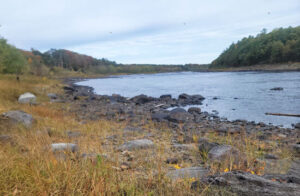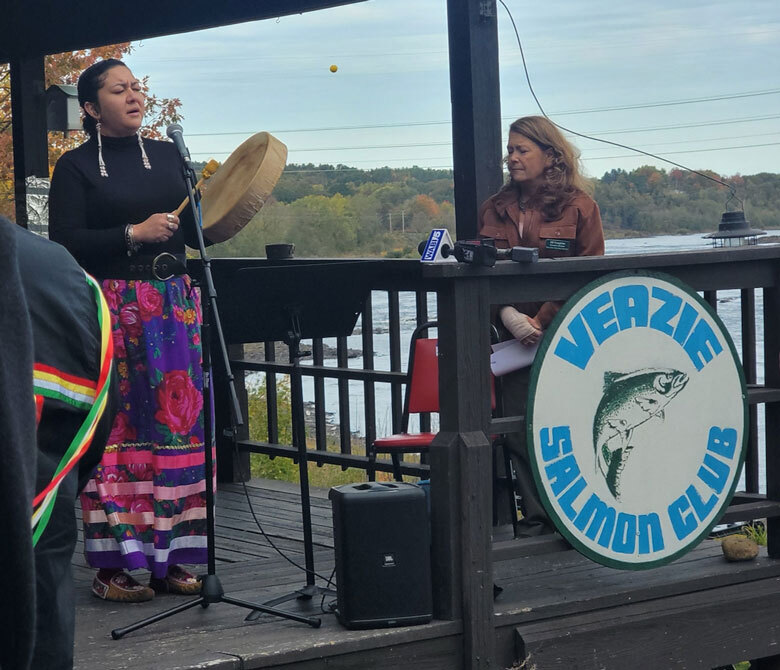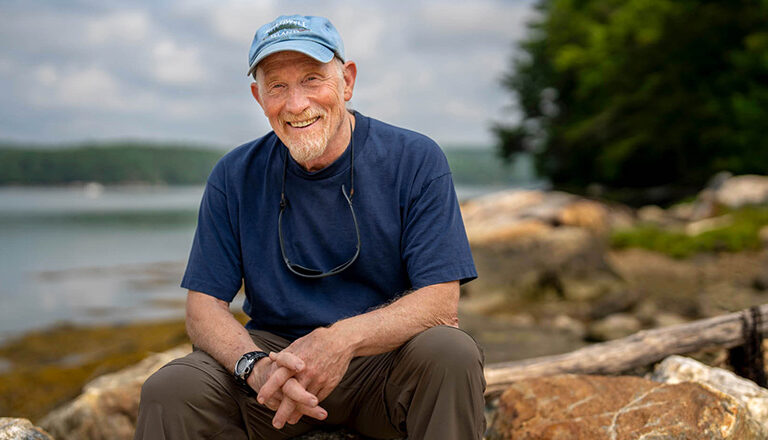For thousands of years, Wabanaki people were sustained by “sea run” fish that moved between rivers and the ocean. Fish evolved this migratory strategy to ensure they would reproduce successfully, but it also resulted in abundant and nutritious food for people, as hundreds of thousands of salmon and millions of shad, river herring, eels, and other fish traveled along shore and between river banks.
In the last few hundred years, Wabanaki people lost access to their traditional fisheries and fish populations declined. This story is told by tribal citizens in a report published by the Maine Indian Tribal-State Commission, released in audio format at an event on Indigenous Peoples’ Day in October.
Robert Polchies, MITSC commissioner from the Penobscot Nation, opened the gathering outside the Veazie Salmon Club with seven breaths to slow down and a prayer. Lauren Stevens sang “The Humbling Song,” her Passamaquoddy words drifting over the Penobscot River rapids.
The numbers of fish are not yet as robust as was hoped, and the challenge to render those fish edible for human sustenance remains.”
MITSC is charged with monitoring the effectiveness of the 1980 Maine Indian Claims Settlement. Among other provisions, the settlement acknowledged the rights of tribal members to harvest fish within reservation boundaries. According to the report, entitled “Sea Run,” the confirmation of tribal fishing rights in 1980 did not offer much because of the limited access Wabanaki people had to their ancestral fishing grounds, and the low quality and quantity of fish, a situation that continues today. Atlantic salmon have been on the endangered species list for more than two decades, and fewer than 800 were counted in Maine rivers in 2025. Other fish that are abundant enough to be harvested are contaminated with mercury, PFAS, and other chemicals, making them dangerous to eat.
“The Penobscot River is our cultural identity and at the very core of who we are,” said Kirk Francis, chief of the Penobscot Nation. “It’s extremely difficult to be Penobscot without a healthy river.”
In agreement with other assessments by federal and state agencies and scientists, the report identifies dams and pollution as the leading factors contributing to declining fish populations.
But authors Judson Esty-Kendall and Anthony Sutton also noted the role of state policies, “whether witting or unwitting,” that inhibited Wabanaki fishing rights and ignored Wabanaki voices. That’s why the authors relied heavily on interviews with tribal citizens, narrated in the audio version by Dawn Neptune Adams, Penobscot; Sue Desiderio, Maliseet; Dale Lolar, Penobscot; and Dwayne Tomah, Passamaquoddy.
Esty-Kendall said he learned a whole new way of looking at Maine’s history through the eyes of the fish, and the Wabanaki people: “It is a story that needs to be told, and needs to be learned.” He described his own personal experience of fish, of being with his grandchildren at the edge of Pushaw Lake watching schools of young alewives, a sea-run species that had declined but has since been restored to numbers again in the millions.
“It’s happening,” he said. “It will take a long time, but it’s happening.”

The report text was less optimistic, noting that while collaboration and “respectful, honest negotiation” have increased fish populations, “the numbers of fish are not yet as robust as was hoped, and the challenge to render those fish edible for human sustenance remains.”
Views differ on the meaning of “sustenance,” which is a term used in Maine law that has no translation in the Wabanaki languages. MITSC recommended further discussion on what is meant by “sustenance.” To support learning and shared understanding, the commission has been awarded a Native Voices Rising grant for statewide education efforts. It also plans to identify and replicate examples of tribal-municipal collaboration for fisheries restoration, said MITSC Executive Director Jill Tompkins, a citizen of the Penobscot Nation.
After the songs and speeches, people mingled next to the river and went inside the clubhouse to get warm. They looked at the wooden walls crowded with displays of flies and rods, and photographs of fly fishermen and their big, silver salmon. Many of those anglers kept and ate their catch, but their sustenance, their traditions, also ended as the fish declined.
The broader impacts of restoring Wabanaki lifeways were highlighted in another report, “Sovereignty Starts Here,” released at the same time by the Maine Center for Economic Policy. “Maine’s future prosperity is tied to justice for the Wabanaki Nations,” wrote James Myall. “Returning public lands to Wabanaki stewardship would both honor history and strengthen Maine’s economy.”
“I don’t look at fish as a problem for just the Passamaquoddy or the Wabanakis,” said another Passamaquoddy citizen interviewed for the “Sea Run” report. “I think it’s just people as a whole, and I think if we have a healthy population and sea-run fish, everyone and everything is going to benefit.”
Catherine Schmitt is the author of The President’s Salmon: Restoring the King of Fish and its Home Waters.





